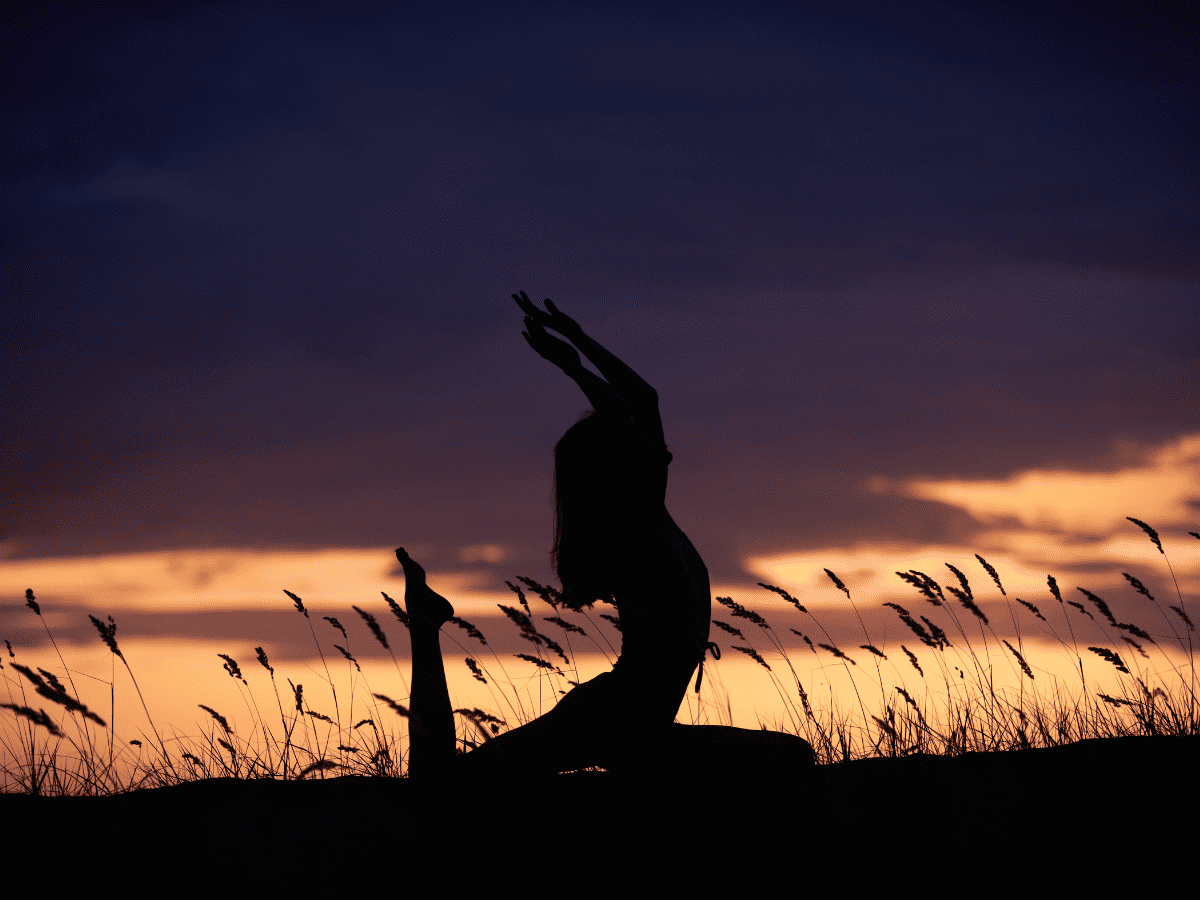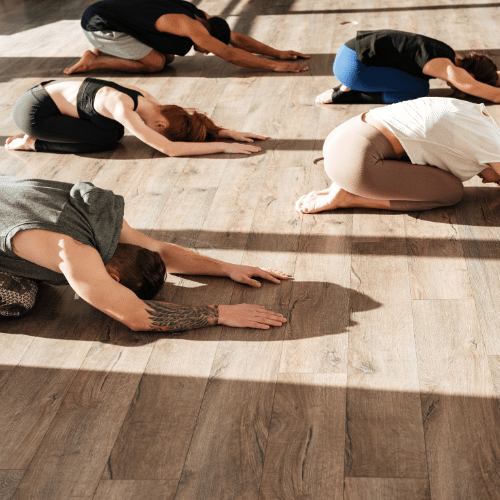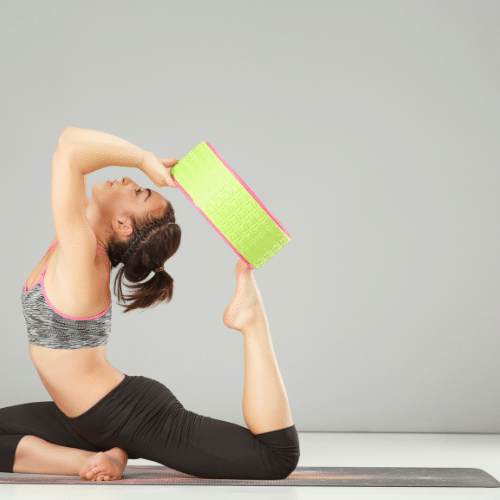As yoga practitioners, we often focus on aligning our energies with the natural elements around us. The Sun and the Moon, two of the most potent sources of cosmic energy, have a unique significance in yoga practice. While the Sun Salutation, or Surya Namaskar, is all about harnessing the active, masculine energy of the Sun, the Moon Salutation, or Chandra Namaskar, celebrates the nurturing and restorative power of the Moon.
This blog post will explore what a Moon Salutation is and how it can benefit your yoga practice.
What Is A Moon Salutation?
A Moon Salutation is a sequence of yoga postures performed in honor of the Moon. The sequence is designed to bring balance and tranquility to the body and mind by activating the lunar energy within. Unlike the active and dynamic nature of Sun Salutation, Lunar Salutation is gentle, restorative, and meditative.
The Moon Salutation sequence typically includes 6-8 postures performed in a particular sequence. Each pose is linked with deep and conscious breathing, creating a smooth energy flow throughout the body. Some of the common poses included in the series are:
1. Mountain Pose (Tadasana)
2. Standing Forward Bend (Uttanasana)
3. Wide-Legged Forward Bend (Prasarita Padottanasana)
4. Crescent Moon Pose (Anjaneyasana)
5. Lizard Pose (Utthan Pristhasana)
6. Sphinx Pose (Salamba Bhujangasana)
7. Half-Pigeon Pose (Ardha Kapotasana)
8. Child’s Pose (Balasana)
9. Corpse Pose (Shavasana)
Moon Salutation is usually performed facing the left side of the mat instead of the right, as is the case with Sun Salutation.
Benefits of Moon Salutation:
Moon Salutation can help you connect with the feminine and intuitive aspects of your being. Here are some of the benefits of including a Lunar Salutation in your yoga practice:
1. Promotes Relaxation
The slow and deliberate movements of Moon Salutations can help you relax and release tension from your body. You can take deep breaths, calming the mind and promoting restful sleep. Practicing Moon Salutations before bed is a great way to unwind your mind and body and prepare for a restful night’s sleep.
2. Increases Flexibility
Moon Salutations involve a variety of stretch and twist postures that can improve the body’s flexibility. The sequence can help stretch your hips, hamstrings, and lower back muscles. Practicing Chandra Namaskar regularly can lead to an overall increase in flexibility, making other yoga poses and daily activities easier.
3. Activates Lunar Energy
The Moon is associated with the feminine and nurturing energies of the universe. Practicing Chandra Namaskar can help you connect with these soulful energies, resulting in a deep sense of peace and tranquility. It can also help you tap into your intuition, which can help in making more empowered decisions for your life.
4. Stabilizes Emotions
Moon Salutations are known to foster emotional balance. The lunar energy, when balanced, can help stabilize your emotions, promoting a sense of calmness and inner harmony. Practicing Chandra Namaskar regularly can help you find that balance within you, leading to a healthier emotional life.
5. Connects with Feminine Energy
Moon Salutations help connect with the divine feminine within you, promoting nurturing, creativity, and spontaneity. It can help women connect with their physical and emotional cycles and find balance in their lives. It is a beautiful way to honor the beauty and power of feminine energy.
6. Improves Overall Well-being
As Chandra Namaskar promotes relaxation, flexibility, emotional stability, and feminine energy, it can help improve your overall well-being. Practicing Moon Salutations regularly can enhance physical, emotional, and spiritual health. It can also improve your quality of life in a multitude of ways.
Differences Between Sun Salutation and Moon Salutation:
1. Energy: As mentioned earlier, Sun Salutation is focused on harnessing the energy of the sun, while Moon Salutation is aimed at honoring the calming and nurturing energy of the Moon. Sun Salutation is known for its energizing and revitalizing effects on the body, while Lunar Salutation is known for its grounding and relaxing effects.
2. Pace: The two yoga sequences also differ in terms of pace. Sun Salutation is a faster-paced sequence, with each posture linked to an inhalation or exhalation. It is often practiced as a warm-up or as a standalone practice. On the other hand, Moon Salutation is a slower and more meditative sequence, allowing for a deeper connection with the breath and a more restful practice.
3. Focus: Sun Salutation is centered around building heat, strength, and stamina in the body, while Moon Salutation focuses on stretching, opening, and releasing tension. Sun Salutation is also often used as a cardiovascular workout, while Lunar Salutation is a great way to wind down after a long day.
4. Time of day: As its name suggests, Sun Salutation is typically practiced in the morning or during the day, while Moon Salutation is best practiced in the evening or at night. Sun Salutation is believed to help awaken and energize the body, while Lunar Salutation can help promote relaxation and restful sleep.
How They Complement Each Other:
While Sun Salutation and Moon Salutation differ in pace, energy, and focus, they share the goal of promoting balance and harmony within the body and mind. Combining both practices in our yoga routine can help us cultivate active and restorative energies. Sun Salutation can help us build strength and stamina, while Lunar Salutation can help us release tension and find inner peace. Practicing both can lead to a more balanced and well-rounded yoga practice.
When To Practice Moon Salutations
Regarding your yoga practice, timing can be crucial in maximizing its benefits. Moon Salutations, or Chandra Namaskar, is a great way to wind down and promote relaxation in the evening or at night. Here are some tips on when to practice Lunar Salutations:
1. In the evening: Lunar Salutations can be a great way to transition from the activity of the day to the calm of the night. As the sun sets, our bodies naturally wind down, and Moon Salutations can help us tap into that energy. The slower, more meditative pace of Lunar Salutations can help release tension in the body and prepare the mind for a restful night’s sleep.
2. During a full moon: The full Moon is a powerful time in nature and can also be a great time to practice Moon Salutations. The full Moon is believed to amplify the energy of the Moon, and practicing Lunar Salutations during this time can help us connect with that energy and tap into our own inner strength and wisdom.
3. When you’re feeling stressed: If you’ve had a long day or are feeling particularly stressed, Moon Salutations can be a great way to release tension and calm the mind. The slower pace of Lunar Salutations and the focus on deep breathing can help activate the body’s relaxation response and promote feelings of peace and calm.
4. As part of a restorative sequence: Moon Salutations can be a great addition to a restorative yoga practice. Restorative yoga is focused on relaxation and rejuvenation, and the slower, more meditative pace of Moon Salutations can complement this type of practice well. Try incorporating Moon Salutations into a restorative sequence for an added dose of relaxation.
In conclusion, Moon Salutations can be a great addition to your yoga practice. By tuning into the calming and nurturing energy of the Moon, we can cultivate a sense of relaxation and inner peace within ourselves. If you’re interested in exploring Lunar Salutations further, consider joining a yoga class or practicing at home with the guidance of an experienced teacher.
At Zuda Yoga, we offer a range of yoga classes, from energizing Vinyasa flows to more restorative Yin practices. Whether you’re a seasoned yogi or a beginner looking to start your journey, we have something for everyone. Join us today and discover the transformative power of yoga in your life.









